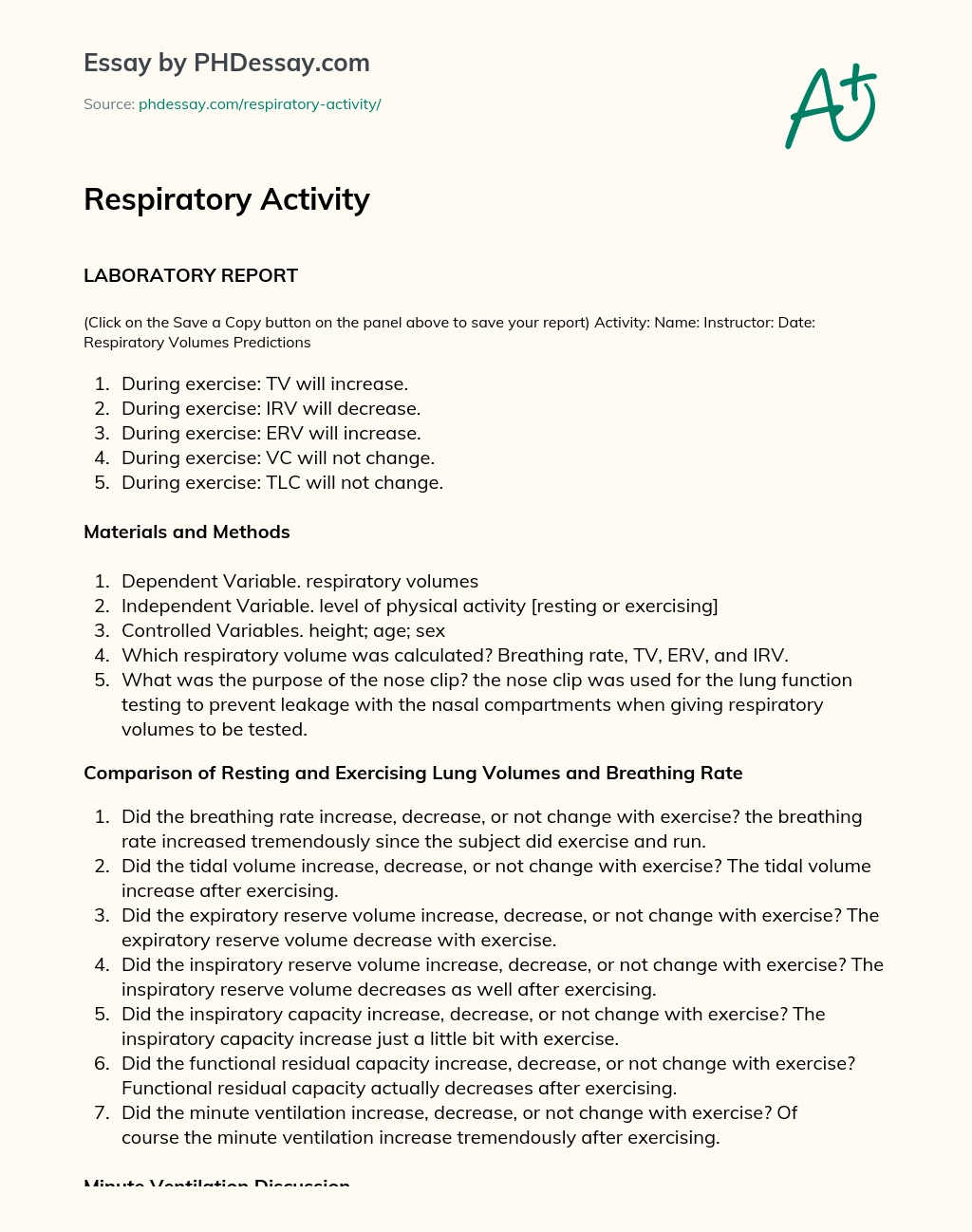Why Does Tv Plateaus at About 60 of Vc but Minute Ventilation Continues to Increase
LABORATORY REPORT
(Click on the Save a Copy button on the panel above to save your report)
Activity: Name: Instructor: Date: Respiratory Volumes Predictions
Order custom essay Respiratory Activity with free plagiarism report
GET ORIGINAL PAPER
- During exercise: TV will increase.
- During exercise: IRV will decrease.
- During exercise: ERV will increase.
- During exercise: VC will not change.
- During exercise: TLC will not change.
Materials and Methods
- Dependent Variable. respiratory volumes
- Independent Variable. level of physical activity [resting or exercising]
- Controlled Variables. height; age; sex
- Which respiratory volume was calculated? Breathing rate, TV, ERV, and IRV.
- What was the purpose of the nose clip? the nose clip was used for the lung function testing to prevent leakage with the nasal compartments when giving respiratory volumes to be tested.
Comparison of Resting and Exercising Lung Volumes and Breathing Rate
- Did the breathing rate increase, decrease, or not change with exercise? the breathing rate increased tremendously since the subject did exercise and run.
- Did the tidal volume increase, decrease, or not change with exercise? The tidal volume increase after exercising.
- Did the expiratory reserve volume increase, decrease, or not change with exercise? The expiratory reserve volume decrease with exercise.
- Did the inspiratory reserve volume increase, decrease, or not change with exercise? The inspiratory reserve volume decreases as well after exercising.
- Did the inspiratory capacity increase, decrease, or not change with exercise? The inspiratory capacity increase just a little bit with exercise.
- Did the functional residual capacity increase, decrease, or not change with exercise? Functional residual capacity actually decreases after exercising.
- Did the minute ventilation increase, decrease, or not change with exercise? Of course the minute ventilation increase tremendously after exercising.
Minute Ventilation Discussion
- Explain the change in ERV with exercise. the ERV decrease with exercise assuming that the volume of air was exhaled more than being inhaled at the time.
- Explain the change in IRV with exercise.
- IRV decreased as well because the amount of air that was supposed to be inhale was very little inhalation during the time of exercising.
- Explain the change in IC with exercise. IC increase with exercise because the subjects were able to allow their lungs to breathe.
- Explain the change in FRC with exercise. The FRC decreases just a little with exercise.
- Explain why RV does not change with exercise. the ERV decrease with exercise assuming that the volume of air was exhaled more than being inhaled at the time.
- Explain why VC does not change with exercise. he vital capacity remains the same because it accumulated the tidal volume, inspiratory reserve volume, and respiratory volume as well with exercise.
- Explain why TLC does not change with exercise. RTLC did not change as well because the vital capacity did not change and so did the residual volume as well remain the same so calculations did not change between these three subjects.
- During exercise, the depth of respiration increases Name the muscles involved in increasing the depth of respiration and explain how muscle contraction causes this increase. he muscles involved in increasing the depth of respiration was the diaphragm, the lungs, the intercostal muscles, muscles of inspiration and expiration as well. Muscle contraction caused the increase because of the diaphragm.
- Explain the importance of the change in minute ventilation with exercise. the change in minute ventilation after exercising increase tremendously because the TV and breathing rate increase the minute ventilation which increased more breaths needed while running to meet higher demand for oxygen.
- Restate your predictions that were correct and give data from your experiment that supports them.
Restate your predictions that were not correct and correct them with supporting data from your experiment.
According to my predictions, I only have one that is wrong and that is that the ERV will increase with exercise but after testing subjects and doing the experiment it has been confirmed that the ERV decrease, so my assumption was by far wrong. But as for my other predictions, it came out to be true according to the experiment, table, and graphs, my assumptions were correct as for these subjects after exercising. Application Minute Ventilation will tend to increase for the simple fact it is the amount of oxygen inspired by the body in a minute. Increased by long term exercise because over time it will adapt to bringing more oxygen to the lungs to work the muscles. During strenuous exercise, TV plateaus at about 60% of VC but minute ventilation continues to increase. Explain how that would occur. an increase in residual volume, and assuming that the TLC does not change with a person with developing emphysema will become short of breath after climbing a flight of stairs will result in the minute if ventilations being obtained while proceeding this type of exercise.

Did you know that we have over 70,000 essays on 3,000 topics in our database?
Cite this page
Explore how the human body functions as one unit in harmony in order to life
Source: https://phdessay.com/respiratory-activity/
Postar um comentário for "Why Does Tv Plateaus at About 60 of Vc but Minute Ventilation Continues to Increase"